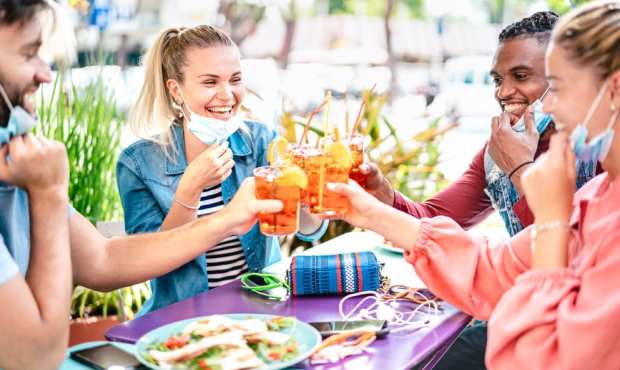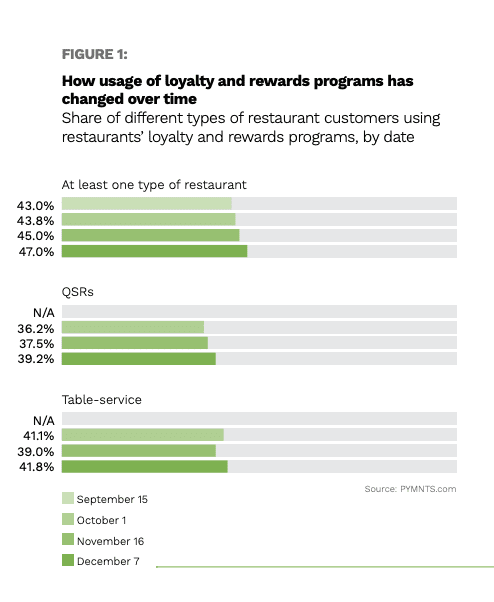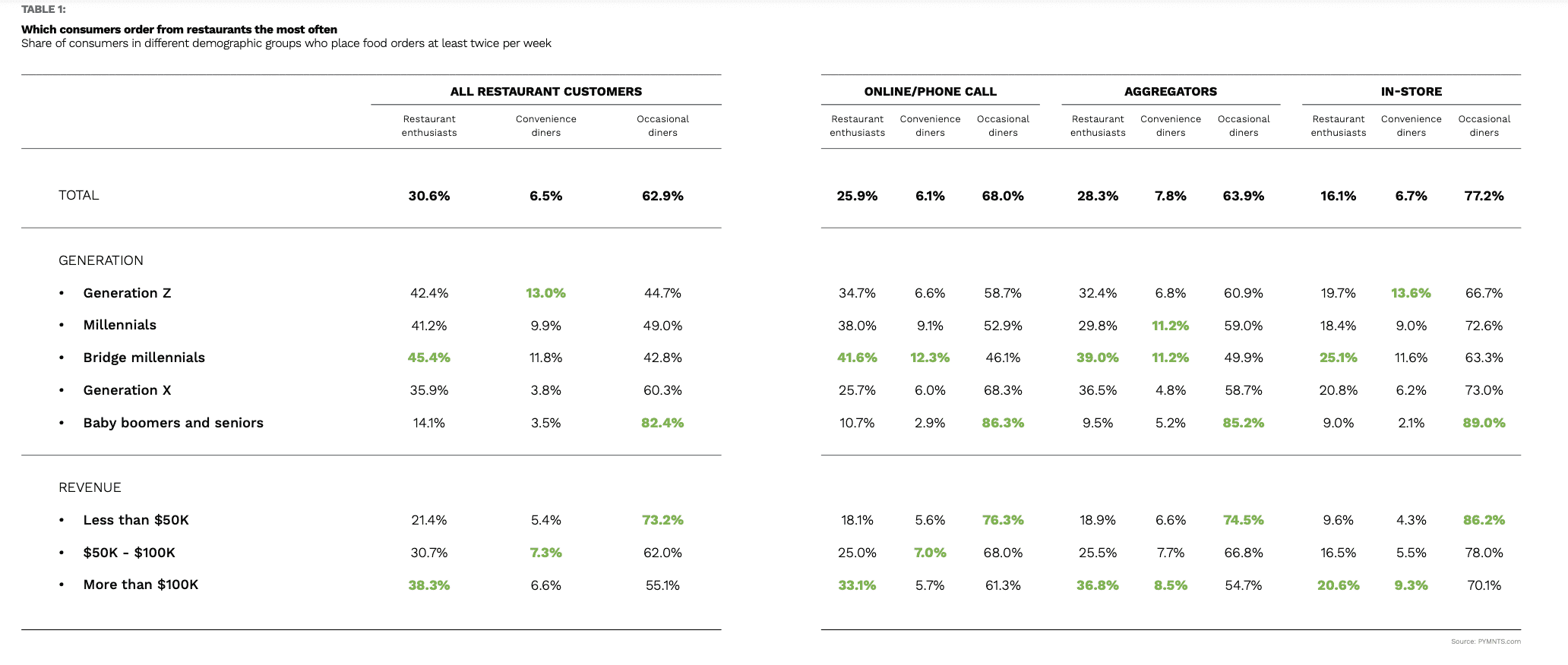How A Year of COVID Has Changed Restaurants, By The Numbers

The last year has been enormously transformative for restaurants. As COVID restrictions and economic fluctuations ate away at traditional revenue sources, the industry took a serious hit. However, the year has also showcased the ingenuity of restaurants, as technological and operational changes were adopted with unprecedented speed, pivoting to off-premises offerings and digital solutions that have moved the industry forward several years in the span of 12 months.
PYMNTS’ monthly Order to Eat and Delivering on Restaurant Rewards Trackers®, created in partnership with Paytronix, offer data-driven insights into these rapid changes in the industry.
At the start of March 2020, a study highlighted in our Order to Eat tracker predicted that 23 percent of smartphone owners would be using food delivery apps by 2023. During the pandemic, that number skyrocketed — a study featured in PYMNTS’ November/December issue of our Order to Eat report noted that 57 percent of consumers had already downloaded a delivery app, a whopping 2.5-fold increase from the initial 2023 prediction.
Similarly, a figure featured in the December 2019 edition projected that Wendy’s digital shares would hit 10 percent of total sales by 2024, and now, reports CNBC, mass digital adoption has condensed that timeframe, expecting to hit the target by 2022. The report also noted that 65 percent of KFC orders were made via drive-thru lanes. Now, the restaurant chain has announced a restaurant redesign around drive-thru orders after they rose 60 percent year over year in 2020’s third quarter, according to QSR Magazine.
Digital ordering exploded over the course of the pandemic. Research from PYMNTS’ January edition of Delivering on Restaurant Rewards finds that of the $486 billion spent by consumers on food eaten at home over the course of 2020, 89 percent was spent on orders placed through digital channels — websites, mobile apps and restaurant aggregators. Additionally, the bulk of these orders were placed at typically sit-down restaurants — $264 billion, or 61 percent, of the $435 billion consumers spent on digital orders was spent at restaurants that had only offered sit-down dining services before March 2020.
Now that so many restaurants have gone digital, they now have to go beyond simply offering online options to set themselves apart from competitors. In the post-pandemic future, personalized rewards will be the difference between leading apps and websites and those that fall behind. In our January edition of the Order to Eat report, researchers found that loyalty programs are the No. 1 feature restaurants can add to attract consumers. In fact, almost four in 10 consumers said they would make more purchases if they could rack up these rewards.
“Guest expectations have changed forever. Exceeding them requires not only improving the loyalty offering, but also using program data to improve the guest experience,” Paytronix Head of Product Michelle Tempesta said in the report. She pointed out that “using artificial intelligence to predict guest behavior, personalize touchpoints, and surprise and delight guests on- and off-premises” can increase campaigns’ effectiveness by a full 25 percent, and that offering personalized menus and targeted offers can also set a restaurant’s offerings apart.
Additionally, our most recent Delivering on Restaurant Rewards report found that restaurants that offer loyalty programs have the ability to convert infrequent customers into devotees. One in five people who only dine out occasionally say they would be most likely to spend more on food orders if they had access to loyalty and rewards programs, and 53 percent of these consumers do not use loyalty and rewards programs simply because they do not believe that such programs are available.
 So what is to come, when we have achieved herd immunity and restaurants begin to find their post-pandemic normal? Our December Delivering on Restaurant Rewards report found that 87 percent of consumers expect to maintain some or all of their online food ordering habits after the virus subsides. The report also found that three out of four consumers who make dine-in restaurant purchases tend to purchase both online and off, suggesting that online orders will remain a key driver for restaurants, even once people feel safe returning to public spaces.
So what is to come, when we have achieved herd immunity and restaurants begin to find their post-pandemic normal? Our December Delivering on Restaurant Rewards report found that 87 percent of consumers expect to maintain some or all of their online food ordering habits after the virus subsides. The report also found that three out of four consumers who make dine-in restaurant purchases tend to purchase both online and off, suggesting that online orders will remain a key driver for restaurants, even once people feel safe returning to public spaces.
That said, restaurants will also likely see a dine-in boom. PYMNTS research found that 61 percent of consumers are interested in eating out in restaurants more often than they currently do. Moreover, higher-income consumers were the most likely to want to dine out more often, indicating that as consumers return to dining on-premises, many will do so with disposable income that they are excited to spend on meaningful culinary experiences.
 To fully take advantage of this pent-up demand, restaurants will need to equip dining areas with more low-contact options for consumers who will likely continue to be more contagion-conscious than they were before the events of the last year. Noodles & Company CEO Dave Boennighausen predicted to Karen Webster in a recent interview that there will be “fewer areas within a restaurant where you could see any kind of communal contact.” One of the more dramatic changes this will include, compared to pre-COVID dining, is that plexiglass partitions will remain a part of the restaurant experience “for the next year or two.”
To fully take advantage of this pent-up demand, restaurants will need to equip dining areas with more low-contact options for consumers who will likely continue to be more contagion-conscious than they were before the events of the last year. Noodles & Company CEO Dave Boennighausen predicted to Karen Webster in a recent interview that there will be “fewer areas within a restaurant where you could see any kind of communal contact.” One of the more dramatic changes this will include, compared to pre-COVID dining, is that plexiglass partitions will remain a part of the restaurant experience “for the next year or two.”
